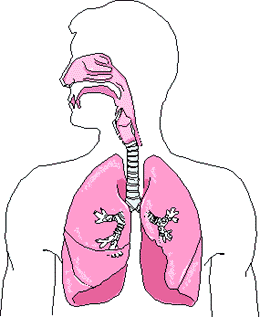 CORE TOPIC:
CORE TOPIC: CORE TOPIC:
CORE TOPIC:
Conducting & Respiratory Parts The conducting part begins with the nasal cavity and mouth, and then opens through the larynx into the trachea. The trachea divides to form two bronchi which branch like a tree to form smaller passages which are the bronchioles. It is lined throughout by respiratory epithelium.
Function of the conducting part
Hyaline cartilage in the walls of the conducting passages provides rigid structural support which maintains the airway and ensures an uninterrupted supply of air to the respiratory part of the system. The epithelial lining of the conducting part of the system, moistens, cleans and warms the air. Mucus secreted by epithelial goblet cells and secretions of mucous and serous glands lying beneath the epithelium, create a wet surface which moistens the air and cleans it by trapping inhaled foreign particles. A rich, superficial vascular network within the walls warms the air.

Respiratory part
The respiratory part is continuous with the conducting part. It consists of the final branches of the bronchial tree
(1) respiratory bronchiole (sometimes called terminal bronchiole)
(2) alveolar duct
(3) alveoli
There is some smooth muscle but no cartilage in the walls of these final branches. The respiratory epithelium is gradually replaced by an extremely thin squamous epithelium.
Function of the respiratory part
Diffusion of oxygen and carbon dioxide occurs in the respiratory portion of the system. There are between 200 and 600 million alveoli in each lung providing an enormous suface area for gaseous exchange (estimated at 70-80 sq m). The alveoli are air sacs with very thin walls containing numerous capillaries. The nature of epithelium which lines the alveoli facilitates the rapid diffusion of gases between the air in the alveoli and the deoxygenated blood in the pulmonary capillaries.
| Core | Supplementary Material |
| Next Topic | - |
| Return to Respiratory System Main Index | |